This fermented honey garlic is the perfect thing to make to boost your immune system! Both honey and garlic have strong medicinal benefits, so you’ll want to have this delicious home remedy on hand for cold and flu season.
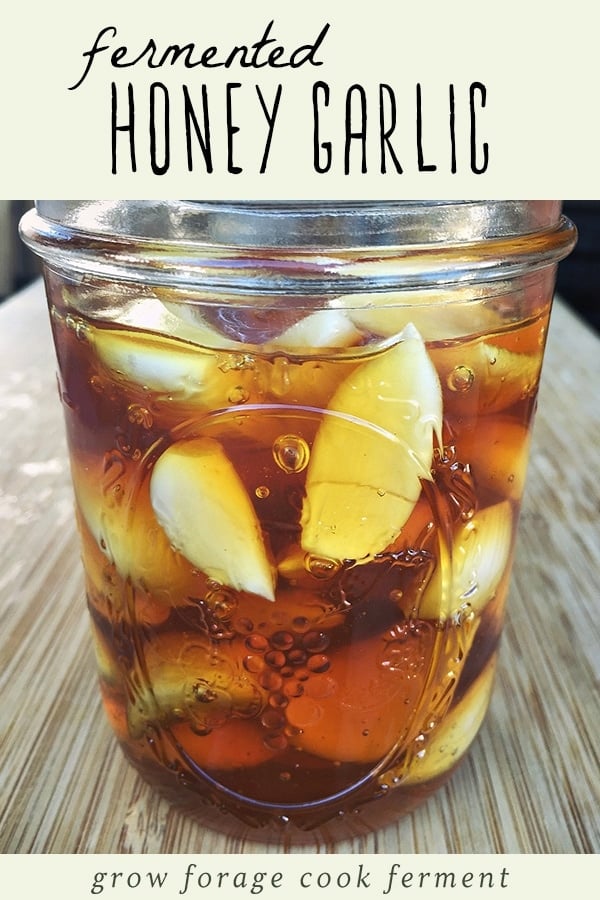
Want to save this post for later?
Fermenting Garlic in Honey
I’m really excited to share this post with you! Fermented honey garlic is something I’ve been wanting to try for a very long time.
I usually reserve my honey for mead making, but using it for other ferments intrigued me. Don’t ask me why I haven’t done it until now, because it’s the easiest thing in the world!
This tasty fermented garlic in honey can be used for many things, as good food and good medicine. Honestly though, I like to just eat it as is!
Fermented Honey Garlic Recipe
Making fermented honey garlic is so easy, it hardly needs a recipe!
Prepare the Garlic
The hardest and most time consuming part is prepping all of the garlic. Whatever size jar you use, you’ll want to fill it about 1/2-3/4 full of peeled garlic.
The quickest and easiest way to prep garlic is to place the side of a chef’s knife on top of a single clove and then give it a firm whack with the palm of your hand.
Don’t do it too hard, as you don’t want to crush the garlic, but just enough to lightly bruise the it. This will make it easy to peel, and will also release a bit of the garlic juice.
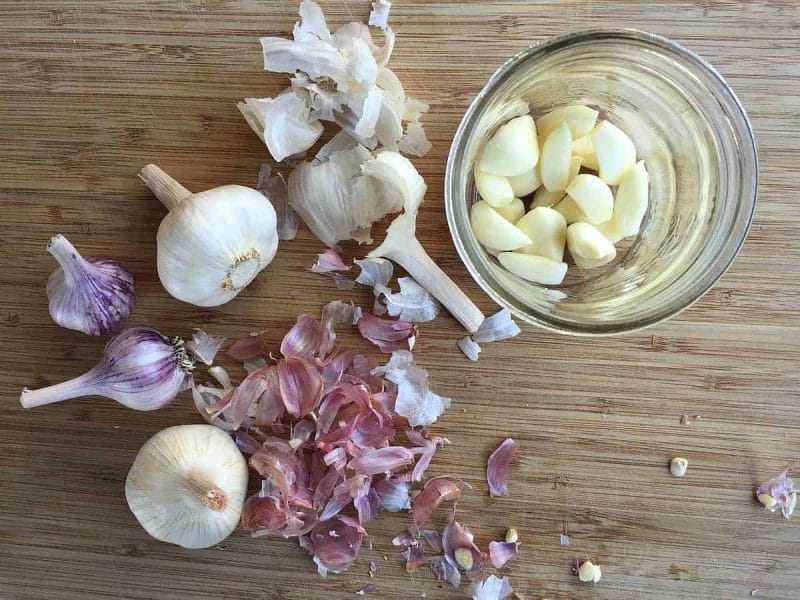
Add the Honey
Once you have enough garlic in your jar, pour in some raw honey to cover it. The garlic will probably float a bit and that’s ok.
It’s important to use raw honey to make fermented garlic in honey, as it will still have all the bacteria and wild yeast that is necessary for fermentation.
When liquid is added to honey, it jump starts the fermentation process. The small amount of juice from the garlic will create just enough liquid for fermentation to happen.
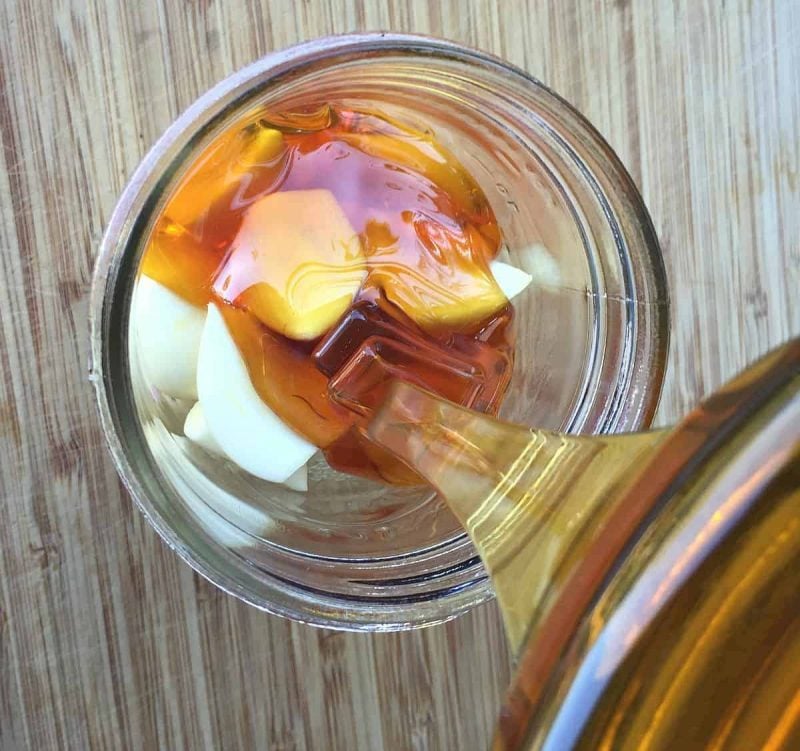
Cover and Flip
Cover the jar loosely with a lid to let the gasses escape, and put it in a dark place to ferment.
It’s a good idea to put a plate or something similar underneath the jar as it’s fermenting, as it will likely bubble up a bit and a little honey could possibly drip out.
It’s also important to gently turn the jar over every day or so, or whenever you think about it, to make sure that all of the garlic stay coated with honey.
Screw the lid on tightly before you do this! Then return it to it’s upright position and re-loosen the lid.
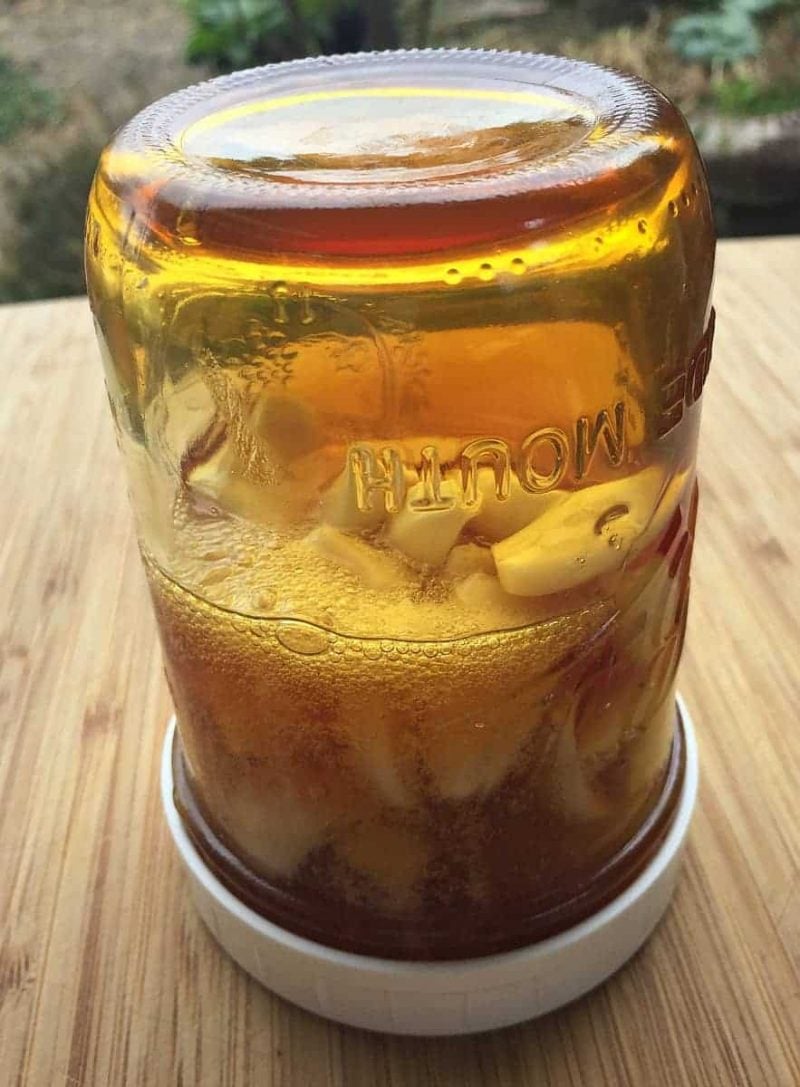
In a few days to a week you will notice some bubbles forming on the surface of the honey. Hooray!
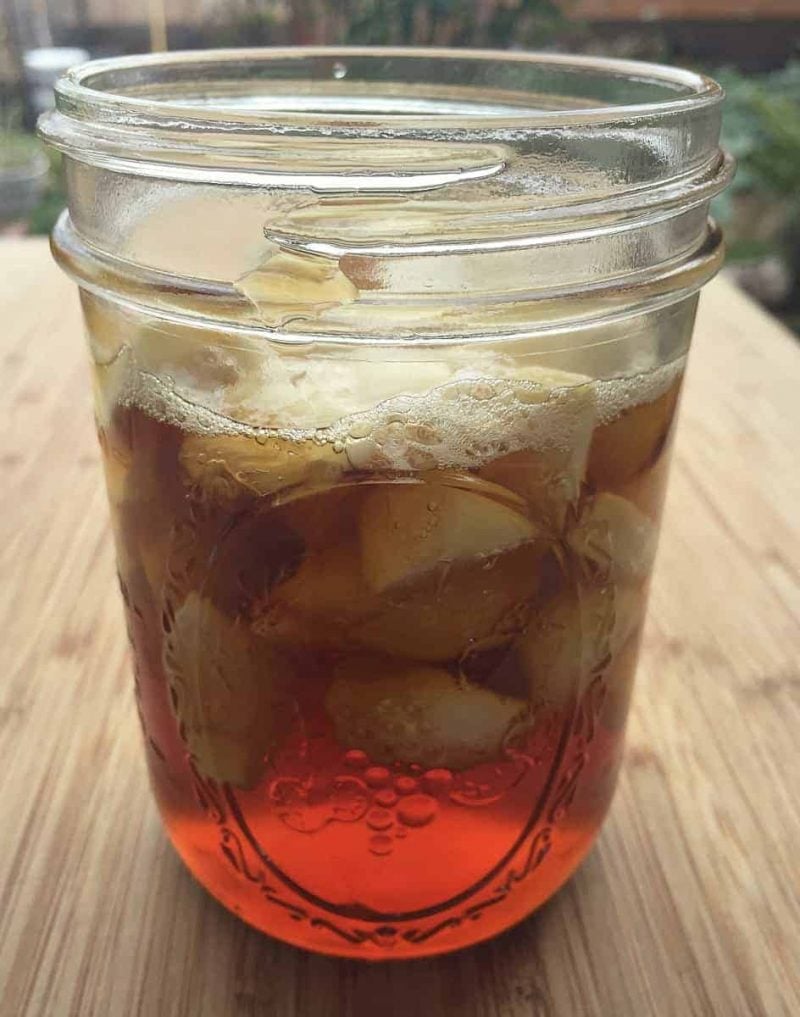
The honey garlic will ferment for about a month, but you can eat it at any time during the process.
The flavor will continue to develop over time, the garlic will mellow, and the honey will become much runnier.
Occasionally the garlic cloves turn a blue or green color due to a reaction during the fermentation process. While it may be a bit alarming, it is not harmful and the honey garlic can still be used.
Honey garlic will store well in a cool place for many months, or even a year or longer! I’ve kept some for over two years and it is still good.
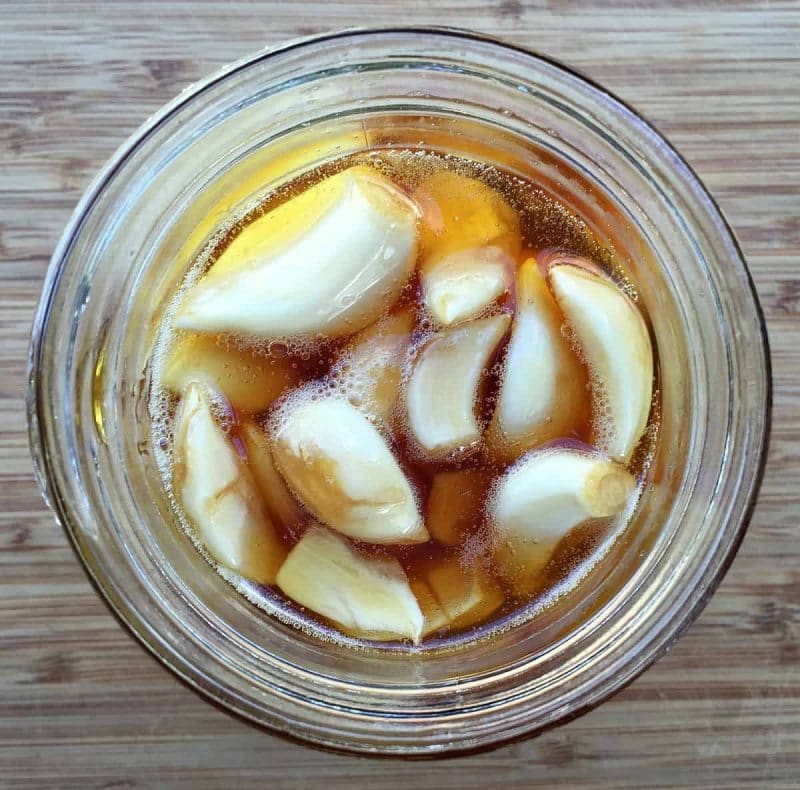
Using Fermented Honey Garlic
Now, how do you use this fermented honey garlic? That’s a good question, and it can be used in a variety of ways.
Both garlic and honey have strong medicinal properties, so it makes sense to use it as an immune booster or if you feel a cold or flu coming on.
Pop a whole garlic clove, or take a spoonful of honey (or both!).
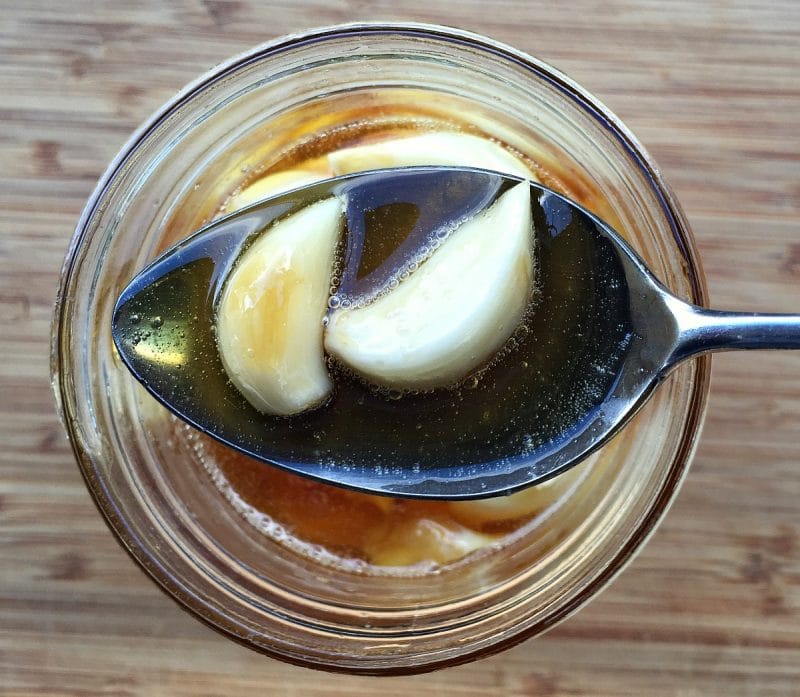
As you can probably imagine, honey garlic also makes a wonderful food!
It’s a natural in marinades and sauces, and would make a really tasty glaze for meats or veggies. Basically anything where you would normally use honey and garlic together!
Is Botulism a Concern in Honey Garlic?
I get this question a lot about fermented honey garlic! The short answer is no, botulism is really not a concern in this type of ferment.
While botulism can happen in garlic and oil preparations without added acidity, the fermentation process that happens here makes it very unlikely.
Raw honey is acidic, and while it can carry botulism spores (which is why it is not recommended for babies under 1 year), the level of acidity stops them from reproducing, which is what causes botulism.
If you are concerned about it, use a pH test strip. Botulism spores can’t reproduce with a pH of less than 4.6. Honey is usually around 3.9, but that can vary between brands.
If the pH is too high, add a splash of raw apple cider vinegar to add more acidity and retest. This is generally not needed, but I did want to mention it.
Honey garlic should not be given to babies under one year of age.
I really hope you make this yummy honeyed garlic! It’s super easy, and great to have on hand. I have a feeling it’s going to become a staple in our house!
Have you ever made fermented honey garlic? How do you use it?
More Fermented and Infused Honey Recipes
Enjoy these other recipes that showcase fermented and infused honey!
- Fermented Honey Cranberries
- Fermented Elderberry Honey
- Herbal Infused Honey
- Lilac Flower Infused Honey
Fermented Honey Garlic
Equipment
Ingredients
- 1 cup whole garlic cloves peeled and slightly crushed
- 1 cup raw honey or more, as needed to cover garlic
Instructions
- Place the peeled garlic cloves into a wide-mouth pint sized mason jar. Add enough honey to completely cover the garlic cloves. Make sure they are coated with honey.
- Place the lid on the jar loosely, then tuck into a dark place.
- Every day or so, tighten the lid on the jar and flip it upside down to coat the garlic cloves with honey. Loosen the lid again when you return it to the upright position.
- Within a few days to a week, you should see small bubbles start to form on the surface of the honey.
- The honey garlic will ferment for about a month, but you can eat it at any time. The flavor will continue to develop over time, the garlic will mellow, and the honey will become much runnier.
- Store in a cool place for many months or even a year, if not longer.
Notes
- It’s important to use raw honey for this recipe, as it has all of the bacteria and wild yeast that is necessary for fermentation.
- The small amount of juice from the garlic will create just enough liquid for fermentation to happen.
- It’s a good idea to put a plate underneath the jar during fermentation, as it will likely bubble up and a little bit of honey could possibly drip out.
- Occasionally the garlic cloves turn a bluish or greenish color during the fermentation process. While it may be a bit alarming, it is not harmful and the honey garlic can still be used.
- If you are concerned about botulism, use a pH test strip. Botulism spores can't reproduce with a pH of less than 4.6. Honey is usually around 3.9, but that can vary between brands.
- If the pH is too high, add a splash of raw apple cider vinegar to add more acidity and retest. This is generally not needed, but I do want to mention it.
- Honey garlic should not be given to babies under one year of age.

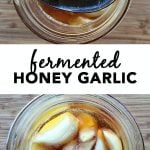
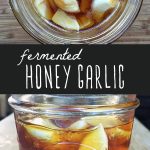
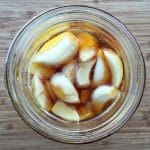

I started making this about 1.5 months ago, and we got a heat wave so it was fermenting well, bubbling enough that the cupboard I had it in smelled like garlic because it had bubbled out the top. I got it in my head thinking about botulism. I wasn’t able to find ph strips in stores so I had to order them. In the mean time I put the ferment in the fridge for a few weeks. When I finally got them today, I tested it and it was about 5.5. I added cuder vinegar and it’s down to 4.5, but because of the time frame, even though it was in the fridge for some of it, would it be a botulism risk?
Hi Kylan. There would be a very, very small risk of botulism.
The mention of botulism scared me, so I purchased the ph strips through your link. I followed instructions but am unsure if I’m reading it right. Any advice?
Hi there. Did instructions come with your pH strips? It’s hard for me to know how to advise you.
Hello. At this time, the best organic garlic I can get has tiny green sprouts beginning to emerge. When a clove is cut open, I find the majority of the garlic clove inside is mostly a sprout-body.
I know spouted things are supposed to be nutritionally power-packed, but that nutrition is in the sprout, not the “jacket” surrounding the sprout. The jacket (i.e. seed husk, or garlic clove) surrounding the sprout is generally depleted as the sprout grows…. isn’t it?
My reason for fermenting the garlic is medicinal, not culinary; so the potency of the end product is all that matters to me.
Now, I have a pound of garlic but all the cloves have begun to sprout a little and I am wondering if I should use the garlic in a honey ferment…. or, would this produce a weak medicinal; not as potent in Allicin(?)
I don’t want to waste honey producing a weak medicinal. So, I’m wondering, if the sprout would add to, or take away from, the allicin potency/content of the garlic clove?
I’m trying to decide whether to ferment the garlic with the sprouts fully intact; or should I just remove the sprouted part; or, should I just wait for fresh unsprouted garlic cloves?
Wish I knew the actual botanical-science answer.
What do you think?
Sprouted garlic is more potent medicinally, so it’s worth a shot fermenting it honey. You could always mince it to release the most allicin.
Great info, can’t wait to try!
I’m wondering if this will attract bugs? Any tips to keeping them away?
I haven’t had a problem.
Hey Colleen , thanks for the recipe, I will try to make it today , I heard there were a lot of benefits to this , just one question will it be better to chop garlic first in order to get Allicin out or it does not matter ? Let me know please thank you again
Hi Bella. Totally up to you.
Hello, I follow the recipe well and have enjoyed a lot of jars of the stuff but this time the taste is off for some reason. It tastes like flat Coke. This time i used pre peeled garlic and I’m not sure if this the reason it tastes off. No mold that I can see.
Hi Jordan. I honestly couldn’t tell you, it could just be the variety of honey or garlic you used this time.
Pre peeled garlic likely has preservatives on it which prevented the fermentation
When I started this last week I forgot I would be away for several days. Can I put it in the fridge while away and take it out when I’m back?
Hi Heather. Yes, that should be fine. It may take additional time to ferment after you remove it from the fridge.
I’m new to this but I have a jar of honey and garlic, not sure if it’s good or not. I mixed garlic and honey in a jar that was recommended. I put it in the fridge. I never new if it fermented or not but after a while it was like something it separated itself. The bottom was creamy looking and the top was honey and garlic. I took it out after a few months and I keep mixing nit but after awhile it separates again I have it out on the counter now. Is it any good. Or should I throw it out ?
Hi Patricia. Honey won’t ferment refrigerated. It’s likely that the cold caused the honey to begin to crystallize. Let it sit in a warm place to return to liquid. Please follow the instructions in my recipe for fermenting it.
Hi! :) I carefully followed your steps and I have tiny bubbles now! yay! I am concerned about one thing: most of the other recipes mention to close the jar very tightly and burp it every now and then. I followed your recommendation to keep a loode lid. I guess it just let the gaz escape but aren’t we slowing the fermentation process? Is it ok for it to be in contact with air? (Îm very new at this)
Hi Mira. No, leaving the jar slightly open doesn’t slow the fermentation process. Make sure you only leave the lid loose, not open. There should only be enough space for pressure to release built-up gases, not for air to get in.
I have a jar that I have been using and the honey is almost all gone and a lot of garlic is still in the jar, can I add more honey or do I throw away the garlic?
No. It’s best to start a new jar every time to reduce the chance of cross-contamination. I would use the garlic and not throw it away.
How much should I take daily when I have a cold/flu? Addressing the question above about spicy garlic, sometimes garlic is super hot. Mine got really hot early on, but months later it’s much milder.
Hi Melanie. You can take as much as you can handle!
I’ve got fermented honey garlic – it’s been sitting for 3 weeks now. But WOWZA! The garlic is SPICY! We eat a lot of garlic, and my husband loves spicy peppers – but this garlic is HOT! HOT! HOT! What didn’t we do right? Any suggestions?
Hi Jessie. It’s really hard for me to say. It may just be a matter of taste.
Do you remove the garlic from the honey?
I don’t.
Wondering if you have ever tried (or have a recipe for) a fermentation mixture of ginger, garlic, lemon, and honey?
I have searched the internet, but have only found variations (i.e. honey/lemon, honey/ginger, honey/garlic/ginger), so I am not sure if the fermentation rate of the different ingredients would work or if the additional amount of liquid from the lemons would impact the fermentation process.
Any information would be greatly appreciated.
Thanks!
Hi Jai. I haven’t tried fermenting those ingredients together, but I’m sure it would work. This recipe is extremely flexible. Put all of those ingredients in a jar, cover it with honey, and let it ferment!
I followed your directions but have a concern about the ph. My starting ph was 5.5. I added cider vinegar, actually 4 times because my husband wanted the ph at around 4 which didn’t happen. 4.5 was the lowest it would go. Out of curiosity I tested a new container of honey and it tested at a 5 ph, so my honey started out high. Should I be concerned?
Do you chew the garlic or swallow it like a pill?
I chew it.
I’m not sure if you received my question. I started my honey garlic ferment about 3 weeks ago, I used raw Y.S.Eco Bee Farms honey and spice world garlic, my garlic is like leather. I don’t understand what happened. Can you help?
Hi Betty. I’m not familiar with either of those brands or if they caused your garlic to be like leather. Can you be more specific? Did you follow all my instructions carefully and did the honey ever show signs of fermentation (bubbles coming to the surface)?
I wonder if the garlic may have been a little dry . . . I’ve had garlic like that, maybe it is not fresh enough. Just my guess.
Can you add cayenne pepper to the garlic honey while fermentation is happening.
Sure!
Hi ,
Was wondering if you could add some herbs at all like rosemary or thyme etc?
Would this hinder the fermentation?
I just figured it would add extra flavour and perhaps have some extra health benefits.
Yes, you can add as many herbs as your heart desires!
Have you ever used the already peeled store bought garlic cloves? If so, were the results compatible?
Thank You.
Hi Lucy, I have not, but as long as they’re organic, they should still ferment.
I’ve had allergic reactions to raw honey in the past, is it possible to use processed honey from the grocery store? Or will fermented honey not cause an allergic reaction?
Hi Amanda. Unfortunately, raw honey is required for fermentation to take place. I can’t say whether or not fermented honey will cause an allergic reaction.
I used regular honey in the past before I knew about raw honey and it fermented just fine, for what it’s worth.
Amanda,
Honey is made from the collection of nectar of plants. Bees collect it, they add enzymes (ok, bee spit) and then dehydrate the nectar to about 12% moisture. So, it could be you have an allergy to any of the flowers (nectar) or the bee spit and or enzymes. Nectar and enzymes are the most probable.
I would suggest that you talk to your general practitioner to determine what the actual allergy is. If it is one of the flowers then you can purchase honey that does not have that nectar and you will have no reaction!
Then again, many people think they have allergies when they are only sensitive to a food. A true allergy will cause an actual LIFE THREATENING EVENT. In my case a bee sting causes extreme swelling and possible closure of my throat as well as breathing problems. An Epi-Pen is mandatory. That is another reason for you to be checked out.
Still don’t understand when the lid can be tightened
When it stops fermenting. When there is no longer any built up gas inside the jar.
Can raw honey that has crystallized be used in honey ferments?
Yes, but you’ll need to gently heat it to bring it back to a liquid state first.
Can I use store bought minced garlic?
If it’s organic, you can try, but I can’t say for sure it’ll ferment.
Do you have to use wide mouth jars.
No, you can use any jar you prefer. I like wide-mouth jars because I can reach my hand inside while cleaning them.
I am new to fermenting and your website is a goldmine! I currently have three different ferments going. I have a garlic lacto-ferment, a sauerkraut ferment, and the honey fermented garlic recipe you have here. All of my ferments have been going for about two weeks now. They are all well submerged under honey or a brine, and are being held submerged by glass fermentation weights. I have the top of each jar covered with cheesecloth because I tend to work long hours and I didn’t want something to explode because I had not made it home in time to burp the jar.
My question is about activity or a lack of activity in the ferment. I have not seen any bubbles in any of the jars. There were a few bubbles on top of the honey fermented garlic, and a very few on top of the lacto-fermented garlic that looked something akin to soap foam that dried and hardened during the first few days of the ferment, and the kitchen smelled strongly of garlic for about the first week but that has now dissipated. The lacto-fermentation garlic has all turned blue and so have a few of the honey fermented garlic, but I understand that is completely natural. Although they have been sitting in a fairly warm house for two weeks there is no mold that I can see on any of the ferments and the cabbage just smells like cabbage. I was wondering since I do not see any bubbles or activity if fermentation is actually taking place? I was expecting to see a lot of bubbles rising to the top of the brine and a lot of fizzing, but so far, no action.
Hi Tony. Lacto ferments are anaerobic, meaning they don’t need oxygen to ferment. The problem with cheesecloth is that it allows too much air and potential contaminants inside the jar, in addition to releasing built-up gases. I highly recommend using some kind of airlock. I really like the Pickle Pipe by Masontops. It will let the gases out and nothing in. When you use a lid with a screw top lod during fermentation, those built-up gases will come to the surface more intensely every time you open your jar to burp it. But because you’re using cheesecloth, it’s likely the bubbles are coming up singularly as they’re produced.
Ah, I understand. Thank you! Does that mean the fermentation is happening but happening slowly? I’ll definitely take your suggestion and get some airlocks, but does this mean that I need to adjust my fermentation time to account for the time they’ve been covered with cheesecloth?
Hi Tony. I would probably try adding a lid and burping for a few days until it doesn’t seem like any bubbles are rising to the surface.
Hi and thanks for the guide!
A question about pH testing. Are we supposed to test when starting the fermentation, or at the end?
Or measure continuously, like start, during and at the end?
I tested for the first time after 2 months and pH is 4.8 in one jar and 5.7 in an other. I made a marinade for some chicken from the first jar, but I don’t dare taste the honey raw.
Hi there. Some people like to test continuously. I would add a splash of apple cider vinegar if you’re concerned.
Is there a certain temperature honey garlic needs to be kept that well fermenting
65-70℉ is ideal.
Do I need to keep the lid loose for the month of fermenting? How do I know when I can tighten the lid to seal the product?
Hi Tracy. When no bubbles come up, it’s safe to put the jar in a cool, dark kitchen area, like in a cabinet.
Hi. My raw liquid unpasteurized honey turned hard after a few days. I bought it from a honey farm. Now it’s just very thick and not fermenting. What should I do?
I would try moving it to a warmer location.
Hi have had my jar for about a year and a half. The garlic as hard as a rock but there’s no mold and it doesn’t smell bad. Is it still OK? Should I toss the garlic and just use the honey?
If there’s no mold and it still smells good, it’s perfectly fine. If the garlic is too hard to eat, I would probably start a new batch, though.